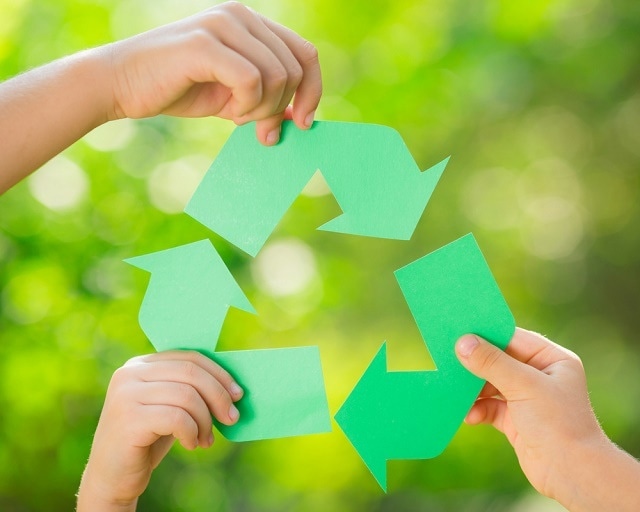
Image Credit: Sunny Studio | Shutterstock.com
According to the Massachusetts Institute of Technology, the average American throws away 3.5 pounds of trash each day, 60% of which could be recycled and reused1.
Since 1960 the amount of trash buried in landfills has nearly doubled, causing these landfills to run out of space, and often overflow. The environmental problems caused by landfills are countless, ranging from landfill fires and subsequent gas release, to serious atmospheric and hydrological effects.
A Positive Impact on the World
Recycling is one of the best ways in which we, as human beings, can attempt to make a positive impact on the world in which we live. Not only does recycling help to reduce the pollution of harmful chemicals and greenhouse gasses released by waste into the environment, it also reduces the need for raw materials, allowing for rainforests and other sources to be preserved.
As the population of the world continues to rise and the need for more products rises with the production of waste, it is imperative to remain environmentally conscious. In order to make the most beneficial impact to the environment, it is important to know exactly which items are meant for garbage or compost.
Recyclable Materials

Image Credit: Wavebreakmedia | Shutterstock.com
Steel
With an overall recycling rate of 88% in 2012, steel is North America’s most recycled material. More steel is recycled each year than aluminum, paper, glass and plastic combined. Since January 1, 2016, it is estimated that 25,482,452 tons of steel have already been recycled, and this number continues to rise each day5.
Obtained mainly from products including cans, cars, appliances and construction materials, scraps of steel can either be re-melted in an electric arc furnace or a basic oxygen furnace for recycling purposes.
Aluminum Cans
Aluminum cans are one of the most recyclable materials, as they are 100% recyclable and can be reprocessed over and over again2. Turning recycled aluminum cans into new cans uses 95% less energy than making new ones. The energy saved by recycling a single aluminum can is equivalent to what is needed to run a television for 3 hours3. In 2015, 54 billion aluminum cans were recycled in the United States, of which the energy saved is equivalent to 15 million barrels of crude oil.
Despite the clear promise of conservation offered by recycling aluminum, it is still estimated that every three months Americans discard enough aluminum to rebuild every single commercial airplane in the United States. In addition to cans, other materials containing aluminum that can be recycled include baking tins, curtain rods, foil, spray cans, and aluminum siding4.
Polyethylene Terephthalate (PET) Plastic Bottles
Another recyclable material is polyethylene terephthalate (PET) plastic bottles. These bottles include both one- and two-liter clear soda bottles, as well as some bottles containing water, liquor, liquid cleaners, detergents, and antacids6. Approximately 1.5 billion pounds of used PET bottles are recovered for recycling in the United States each year, making PET the most widely recycled plastic in the world. Recycling PET preserves two-thirds of the energy normally required to make new plastic, which successfully lowers greenhouse gas emissions and dramatically reduces solid waste generation.
Recovered PET products can be reused continuously into new PET containers, carpet, clothing, protective packaging, industrial strapping, automotive parts, construction materials, and much more7. Despite this, it is estimated that the average American household uses 45 pounds PET plastic bottles and jars each year, and 80% of these bottles will end up on a landfill. While PET is an inert material, making it resistant to attack by microorganisms and posing little risk of contaminating groundwater when buried in a landfill, it is still a highly valuable material when recycled properly. Recycling PET bottles and containers is a simple and environmentally responsible way to ensure a more sustainable future7.
Newspapers
Newspapers are a very important material to recycle, despite accounting for approximately one-third of the municipal waste stream in the United States alone. Within a landfill, where 80% of discarded paper ends up, the decomposition of paper produces methane, a greenhouse gas that has 21 times the heat-trapping power of carbon dioxide8.
Within landfills, the decomposition of paper is the most significant source of methane, causing these materials to perpetuate global climate changes caused by these emissions. Recycling paper reduces the amount that ends up in landfills, decreasing the production of these toxic greenhouse gas emissions.
Aside from the energy benefits, one of the most significant motivations for recycling newspapers is to preserve forests, by reducing the number of trees that are cut down to make paper. In fact, recycling a single run of the Sunday New York Times could save approximately 75,000 trees. Recycling paper also reduces the intensity for forest management typically required for cutting down trees, preserving wildlife habitat and biodiversity in these areas8.
Further Materials Suitable for Recycling
Other materials that are particularly useful for recycling purposes include corrugated cardboard, steel cans, high-density polyethylene (HDPE) plastic bottles, glass containers, and computers2. With the proper recycling technologies, each of these materials discussed can offer sustainable options for the improvement of the global environment.
References and Further Reading
- Recycling Facts
- Top 10 Most Important Items to Recycle
- How to Recycle Aluminum Cans - Earth911.com
- Department of Environmental Conservation
- Steel: The EnviroMetal
- 3 Recyclable Materials - A Practical Recycling Handbook (1994): 24-48. Web.
- Recycling
- Q & A on the Environmental Benefits of Recycled Paper
Disclaimer: The views expressed here are those of the author expressed in their private capacity and do not necessarily represent the views of AZoM.com Limited T/A AZoNetwork the owner and operator of this website. This disclaimer forms part of the Terms and conditions of use of this website.